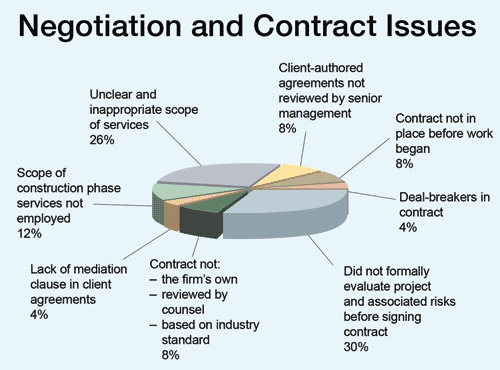Managing Client Expectations to Reduce Professional Liability Risk
Scope of Services
Your contract's scope of services, or the acknowledgment of which services you will and will not provide during the project, is one of the primary methods you have for setting and managing expectations.
As simple as defining one's scope of services may sound to some, it can present quite a challenge. Robert J. Smith, a Madison, Wisconsin-based lawyer with Akerman Senterfitt Wickwire Gavin, who is counsel emeritus to the Engineers Joint Contract Documents Committee, says that inadequate scopes of services are very common because contracts are often drawn up quickly based upon previous contracts. "Often, in the heat of competition and the enthusiasm to get going, you get a vague or generic scope of services that can lead to differing expectations," he warns.
|
|
Perhaps another example from the claims files can best illustrate the danger of having an undefined or poorly written scope of services.
Prior to the purchase of a large apartment building complex, an engineering firm was subcontracted to perform portions of a property assessment related to mechanical, plumbing, electrical, and fire protection systems. The firm's fee for a one-day assessment and report was just over $3,000.
Once the assessment was performed and the complex was purchased, there were major problems with water leaks throughout the complex. The purchaser of the complex, who became "the plaintiff," alleged that the engineering firm should have identified the leaks as a problem and notified the purchasers about them.
While a well-defined scope of services within the engineering firm's contract could possibly have helped the firm successfully defend against the claim, the firm had used an ill-fitting form contract with a vague, at best, scope of services.
As a result, and despite the fact that the engineering firm was being paid so little, the purchaser had developed an unrealistic expectation that a "clean bill of health" from the engineers amounted to a guarantee or warranty that there were no problems with the complex. A well-defined scope would have specified the extent of the engineers' one-day assessment. The result was a six-figure settlement of the engineering firm's liability.
A detailed and clearly defined scope of services, written into the contract and communicated to the project team, helps designers stick to the services they promised to provide. The moment an architect or engineer veers from the scope, or, as noted above, performs work in the absence of a clear scope, there exists the possibility of increasing client expectations and taking on additional liabilities.
According to Lewis, "The scope of services should include the following three elements: Services the design professional will perform for a basic fee; services available to the client for an additional fee; and services excluded because the consultant doesn't provide them, the client has refused them, or the client has sought those services from a third party."¹










